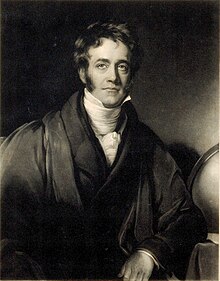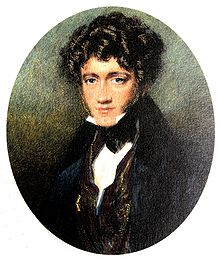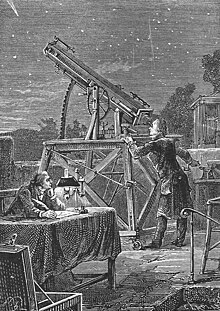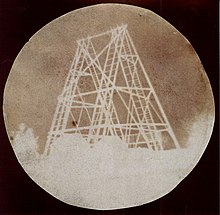John Herschel
John Herschel | |
|---|---|
 John Herschel, 1835mezzotintby W. Ward, after H. W. Pickersgill | |
| Born | John Frederick William Herschel 7 March 1792[1] Slough,Buckinghamshire,England |
| Died | 11 May 1871(aged 79)[1] |
| Resting place | Westminster Abbey |
| Education | Eton College |
| Alma mater | St John's College, Cambridge |
| Known for | Contributions to the invention of photography |
| Spouse | Margaret Brodie Stewart |
| Awards |
|
| Scientific career | |
| Fields | |
Sir John Frederick William Herschel, 1st BaronetKHFRS(/ˈhɜːrʃəl,ˈhɛər-/;[2]7 March 1792 – 11 May 1871)[1]was an Englishpolymathactive as amathematician,astronomer,chemist,inventor and experimental photographer who invented theblueprint[3][4][5]and didbotanicalwork.[6]
Herschel originated the use of theJulian daysystem inastronomy.He named sevenmoons of Saturnand fourmoons of Uranus– the seventh planet, discovered by his fatherSir William Herschel.He made many contributions to the science of photography, and investigatedcolour blindnessand the chemical power ofultravioletrays. HisPreliminary Discourse(1831), which advocated aninductive approachto scientific experiment and theory-building, was an important contribution to thephilosophy of science.[7]
Early life and work on astronomy[edit]



Herschel was born inSlough,Buckinghamshire, the son of Mary Baldwin and astronomerSir William Herschel.He was the nephew of astronomerCaroline Herschel.He studied shortly atEton CollegeandSt John's College, Cambridge,graduating asSenior Wranglerin 1813.[8]It was during his time as an undergraduate that he became friends with the mathematiciansCharles BabbageandGeorge Peacock.[6]He left Cambridge in 1816 and started working with his father. He took up astronomy in 1816, building areflecting telescopewith a mirror 18 inches (460 mm) in diameter, and with a 20-foot (6.1 m)focal length.Between 1821 and 1823 he re-examined, withJames South,the double stars catalogued by his father.[9]He was one of the founders of the Royal Astronomical Society in 1820. For his work with his father, he was presented with theGold Medal of the Royal Astronomical Societyin 1826 (which he won again in 1836), and with theLalande Medalof theFrench Academy of Sciencesin 1825, while in 1821 theRoyal Societybestowed upon him theCopley Medalfor his mathematical contributions to their Transactions. Herschel was made a Knight of theRoyal Guelphic Orderin 1831.[6]He also seemed to be aware of Indian thought and mathematics introduced to him byGeorge Everestas claimed by Mary Boole:[10]
Some time about 1825, he came to England for two or three years, and made a fast and lifelong friendship with Herschel and with Babbage, who was then quite young.(.) My uncle returned from India. He never interfered with anyone's religious beliefs or customs. But no one under his influence could continue to believe in anything in the Bible being specially sacred, except the two elements which it has in common with other sacred books: the knowledge of our relation to others and of man's power to hold direct converse with the unseen truth.
He stated in his historical articleMathematics in Brewster's Cyclopedia:
The Brahma Sidd'hanta, the work of Brahmagupta, an Indian astronomer at the beginning of the seventh century, contains a general method for the resolution of indeterminate problems of the second degree; an investigation which actually baffled the skill of every modern analyst till the time of Lagrange's solution, not excepting the all inventive Euler himself.[10][11]
Herschel served aspresident of the Royal Astronomical Societythree times: 1827–1829, 1839–1841 and 1847–1849.[12][13]
Herschel'sA preliminary discourse on the study of natural philosophy,published early in 1831 as part ofDionysius Lardner's Cabinet cyclopædia,set out methods of scientific investigation with an orderly relationship between observation and theorising. He described nature as being governed by laws which were difficult to discern or to state mathematically, and the highest aim ofnatural philosophywas understanding these laws throughinductive reasoning,finding a single unifying explanation for a phenomenon. This became an authoritative statement with wide influence on science, particularly at theUniversity of Cambridgewhere it inspired the studentCharles Darwinwith "a burning zeal" to contribute to this work.[14][15][16]
He was elected as a member to theAmerican Philosophical Societyin 1854.[17]
Herschel published a catalogue of his astronomical observations in 1864, as theGeneral Catalogue of Nebulae and Clusters,a compilation of his own work and that of his father's, expanding on the senior Herschel'sCatalogue of Nebulae.A further complementary volume was published posthumously, as theGeneral Catalogue of 10,300 Multiple and Double Stars.
Herschel correctly considered astigmatism to be due to irregularity of the cornea and theorised that vision could be improved by the application of some animal jelly contained in a capsule of glass against the cornea. His views were published in an article entitled Light in 1828 and theEncyclopædia Metropolitanain 1845.[18]
Discoveries of Herschel include the galaxiesNGC 7,NGC 10,NGC 25,andNGC 28.


Visit to South Africa[edit]
He declined an offer from theDuke of Sussexthat they travel toSouth Africaon aNavy ship. [19] Herschel had his own inherited money and he paid £500 for passage on the S.S.Mountstuart Elphinstone.He, his wife, their three children and his 20 inch telescope departed fromPortsmouthon 13 November 1833.[1]
The voyage to South Africa was made to catalogue the stars,nebulae,and other objects of the southern skies.[6]This was to be a completion as well as extension of the survey of the northern heavens undertaken initially by his fatherWilliam Herschel.He arrived inCape Townon 15 January 1834 and set up a private 21 ft (6.4 m) telescope at Feldhausen atClaremont,a suburb ofCape Town.Amongst his other observations during this time was that of the return ofComet Halley.Herschel collaborated withThomas Maclear,the Astronomer Royal at the Cape of Good Hope and the members of the two families became close friends. During this time, he also witnessed the Great Eruption ofEta Carinae(December 1837).
In addition to his astronomical work, however, this voyage to a far corner of theBritish empirealso gave Herschel an escape from the pressures under which he found himself in London, where he was one of the most sought-after of all British men of science. While insouthern Africa,he engaged in a broad variety of scientific pursuits free from a sense of strong obligations to a larger scientific community. It was, he later recalled, probably the happiest time in his life.[20]Avillagein the contemporary province ofEastern Capeis named after him.
Herschel combined his talents with those of his wife, Margaret, and between 1834 and 1838 they produced 131 botanical illustrations of fine quality, showing the Cape flora. Herschel used acamera lucidato obtain accurate outlines of the specimens and left the details to his wife. Even though their portfolio had been intended as a personal record, and despite the lack of floral dissections in the paintings, their accurate rendition makes them more valuable than many contemporary collections. Some 112 of the 132 known flower studies were collected and published asFlora Herschelianain 1996. The book also included work byCharles Davidson Belland Thomas Bowler.[21]
As their home during their stay in the Cape, the Herschels had selected 'Feldhausen' ( "Field Houses" ),[21]an old estate on the south-eastern side ofTable Mountain.Here John set up his reflector to begin his survey of the southern skies.
Herschel, at the same time, read widely. Intrigued by the ideas of gradual formation of landscapes set out inCharles Lyell'sPrinciples of Geology,he wrote to Lyell on 20 February 1836 praising the book as a work that would bring "a complete revolution in [its] subject, by altering entirely the point of view in which it must thenceforward be contemplated" and opening a way for bold speculation on "that mystery of mysteries, the replacement of extinct species by others." Herschel himself thoughtcatastrophic extinction and renewal"an inadequate conception of the Creator" and by analogy with otherintermediate causes,"the origination of fresh species, could it ever come under our cognizance, would be found to be a natural in contradistinction to a miraculous process".[22][23]He prefaced his words with the couplet:
He that on such quest would go must know not fear or failing
To coward soul or faithless heart the search were unavailing.
Taking a gradualist view of development and referring to evolutionary descent from aproto-language,Herschel commented:
Words are to the Anthropologist what rolled pebbles are to the Geologist – battered relics of past ages often containing within them indelible records capable of intelligent interpretation – and when we see what amount of change 2000 years has been able to produce in the languages of Greece & Italy or 1000 in those of Germany France & Spain we naturally begin to ask how long a period must have lapsed since the Chinese, the Hebrew, the Delaware & the Malesass [Malagasy] had a point in common with the German & Italian & each other – Time! Time! Time! – we must not impugn the Scripture Chronology, but wemustinterpret it in accordance withwhatevershall appear on fair enquiry to be thetruthfor there cannot be two truths. And really there is scope enough: for the lives of the Patriarchs may as reasonably be extended to 5000 or 50000 years apiece as the days of Creation to as many thousand millions of years.[24][25]
The document was circulated, andCharles Babbageincorporated extracts in his ninth and unofficialBridgewater Treatise,which postulated laws set up by a divine programmer.[22]WhenHMSBeaglecalled atCape Town,CaptainRobert FitzRoyand the young naturalistCharles Darwinvisited Herschel on 3 June 1836. Later on, Darwin would be influenced by Herschel's writings in developing his theory advanced inThe Origin of Species.In the opening lines of that work, Darwin writes that his intent is "to throw some light on the origin of species – that mystery of mysteries, as it has been called by one of our greatest philosophers," referring to Herschel. However, Herschel ultimately rejected the theory of natural selection.[26]
Herschel returned to England in 1838, was created abaronet,of Slough in the County of Buckingham,[6]and publishedResults of Astronomical Observations made at the Cape of Good Hopein 1847. In this publication he proposed the names still used today for the seven then-known satellites ofSaturn:Mimas,Enceladus,Tethys,Dione,Rhea,Titan,andIapetus.[27]In the same year, Herschel received his second Copley Medal from the Royal Society for this work. A few years later, in 1852, he proposed the names still used today for the four then-known satellites ofUranus:Ariel,Umbriel,Titania,andOberon.A stone obelisk, erected in 1842 and now in the grounds ofThe Grove Primary School,marks the site where his 20-ft reflector once stood.[28]
Photography[edit]


Herschel made numerous important contributions to photography. He made improvements inphotographic processes,particularly in inventing thecyanotype[30]process, which became known asblueprints,[3][4][5]and variations, such as thechrysotype.In 1839, he made a photograph on glass, which still exists, and experimented with some colour reproduction, noting that rays of different parts of the spectrum tended to impart their own colour to aphotographic paper.Herschel made experiments usingphotosensitiveemulsions of vegetable juices, called phytotypes, also known asanthotypes,and published his discoveries in the Philosophical Transactions of theRoyal Societyof London in 1842.[31]He collaborated in the early 1840s withHenry Collen,portrait painter toQueen Victoria.Herschel originally discovered the platinum process on the basis of the light sensitivity of platinum salts, later developed byWilliam Willis.[32]
Herschel coined the termphotographyin 1839.[33][34]Herschel was also the first to apply the termsnegativeandpositiveto photography.[6]
Herschel discoveredsodium thiosulfateto be a solvent of silverhalidesin 1819,[35]and informedTalbotandDaguerreof his discovery that this "hyposulphite of soda" ( "hypo" ) could be used as aphotographic fixer,to "fix" pictures and make them permanent, after experimentally applying it thus in early 1839.
Herschel's ground-breaking research on the subject was read at the Royal Society in London in March 1839 and January 1840.
Other aspects of Herschel's career[edit]
Herschel wrote many papers and articles, including entries on meteorology, physical geography and the telescope for the eighth edition of theEncyclopædia Britannica.[6]He also translated theIliadof Homer.
In 1823, Herschel published his findings on the optical spectra of metal salts.[36]
Herschel invented theactinometerin 1825 to measure the direct heating power of the Sun's rays,[37]and his work with the instrument is of great importance in the early history ofphotochemistry.

Herschel proposed a correction to the Gregorian calendar, making years that are multiples of 4000common yearsrather thanleap years,thus reducing the average length of thecalendar yearfrom 365.2425 days to 365.24225.[38]Although this is closer to themean tropical yearof 365.24219 days, his proposal has never been adopted because theGregorian calendaris based on the mean time between vernalequinoxes(currently365.242374days).[39]
Herschel was elected a Foreign Honorary Member of theAmerican Academy of Arts and Sciencesin 1832,[40]and in 1836, a foreign member of theRoyal Swedish Academy of Sciences.
In 1835, theNew York Sunnewspaper wrote a series of satiric articles that came to be known as theGreat Moon Hoax,with statements falsely attributed to Herschel about his supposed discoveries of animals living on the Moon, including batlike winged humanoids.
Several locations are named for him: the village ofHerschelin westernSaskatchewan,Canada,site of the discovery ofDolichorhynchops herschelensis,a type ofplesiosaur;Mount HerschelinAntarctica;the craterJ. Herschelonthe Moon;and the settlement ofHerschel, Eastern Capeand theHerschel Girls' SchoolinCape Town,South Africa.
While it is commonly accepted that Herschel Island, in the Arctic Ocean, part of theYukon Territory,was named after him, the entries in the expedition journal of SirJohn Franklinstate that the latter wished to honour the Herschel family, of which John Herschel's father, SirWilliam Herschel,and his aunt,Caroline Herschel,are as notable as John.[41]


Family[edit]
Herschel marriedMargaret Brodie Stewart(1810–1884) on 3 March 1829[1]at St. Marlyebone Church in London, and was father of the following children:[42]
- Caroline Emilia Mary Herschel (31 March 1830 – 29 January 1909), who married the soldier and politicianAlexander Hamilton-Gordon
- Isabella Herschel (5 June 1831 – 1893)
- SirWilliam James Herschel,2nd Bt. (9 January 1833 – 1917),
- Margaret Louisa Herschel (1834–1861), an accomplished artist
- Alexander Stewart Herschel(1836–1907), FRS, FRAS
- Col.John HerschelFRS, FRAS, (1837–1921) surveyor
- Maria Sophia Herschel (1839–1929)
- Amelia Herschel (1841–1926) married SirThomas Francis Wade,diplomat and sinologist
- Julia Herschel (1842–1933) married on 4 June 1878 to Captain (laterAdmiral)John Fiot Lee Pearse Maclear
- Matilda Rose Herschel (1844–1914), a gifted artist, married William Waterfield (Indian Civil Service)
- Francisca Herschel (1846–1932)
- Constance Anne Herschel(1855–20 June 1939), mathematician and scientist who became lecturer in natural sciences atGirton College, Cambridge
Death[edit]

Herschel died on 11 May 1871 at age 79 at Collingwood, his home nearHawkhurstin Kent. On his death, he was given a national funeral and buried inWestminster Abbey.[43]
His obituary by Henry W Field of London was read to theAmerican Philosophical Societyon 1 December 1871.[44]
Arms[edit]
 |
|
Bibliography[edit]
In chronological order

- "On the Hyposulphurous Acid and its Compounds".The Edinburgh Philosophical Journal.1:19. 1819.Retrieved15 April2011.
- On the Aberration of Compound Lenses and Object-Glasses.London: W. Bulmer and W. Nicol. 1821.,"Abstract".The Royal Society.1831.JSTOR109979.
- Treatises onPhysical Astronomy, LightandSound,Contributed to the Encyclopaedia Metropolitana.London: Richard Griffin.(TheEncyclopædia Metropolitanawas published in 30 vols. from 1817–1845)
- "On the Absorption of Light by Coloured Media, and on the Colours of the Prismatic Spectrum Exhibited by Certain Flames; with an Account of a Ready Mode of Determining the Absolute Dispersive Power of Any Medium, by Direct Experiment".Transactions of the Royal Society of Edinburgh.9(2): 445–460. 1823.doi:10.1017/S008045680003101X.S2CID101517638.
- A Treatise on Astronomy(3rd ed.). Philadelphia: Carey, Leah and Blanchard. 1835.
- "On the Chemical Action of the Rays of the Solar Spectrum on Preparations of Silver and Other Substances, Both Metallic and Non-Metallic, and on Some Photographic Processes",Philosophical Transactions of the Royal Society of London,130:1–59, 20 February 1840,Bibcode:1840RSPT..130....1H,doi:10.1098/rstl.1840.0002,ISSN0261-0523,JSTOR108209,S2CID98119765.
- "On the Action of the Rays of the Solar Spectrum on Vegetable Colours, and on Some New Photographic Processes",Philosophical Transactions of the Royal Society of London,132:182–214, 1842,Bibcode:1842RSPT..132..181H,doi:10.1098/rstl.1842.0013
- Results of Astronomical Observations Made During the Years 1834, 5, 6, 7, 8, at the Cape of Good Hope: Being the Completion of a Telescopic Survey of the Whole Surface of the Visible Heavens, Commenced in 1825,London: Smith, Elder and Co., 1847
- John Herschel, ed. (1849).Manual of Scientific Inquiry, Prepared for the Use of Officers in Her Majesty's Navy, and Travellers in General.LCCN05022489.
- "Meteorology".Encyclopædia britannica.1861.
- A General Catalogue of Nebulæ and Clusters of Stars.1864.
- Familiar Lectures on Scientific Subjects.George Routledge & Sons. 1869.Bibcode:1869flss.book.....H.
- R. Main; C. Pritchard, eds. (1874).A Catalogue of 10,300 Multiple and Double Stars, Arranged in the Order of Right Ascension.
- Outlines of Astronomy.D. Appleton and Company. 1876a.
- Popular Lectures on Scientific Subjects.London: Dalby, Isbister & Co. 1876b.
- A Preliminary Discourse on the Study of Natural Philosophy.London: Longman, Rees, Orme, Brown & Green. 1880.
References[edit]
- ^abcdeCrowe, Michael J. "Herschel, Sir John Frederick William, first baronet (1792–1871)".Oxford Dictionary of National Biography(online ed.). Oxford University Press.doi:10.1093/ref:odnb/13101.(Subscription orUK public library membershiprequired.)
- ^"Herschel".Random House Webster's Unabridged Dictionary.Archived fromthe originalon 30 May 2016.
- ^abGo, F. E. (1970). "Blueprint".Encyclopædia Britannica.Vol. 3 (Expo'70 ed.). Chicago: William Benton. p. 816.
- ^abBridgwater, William; Sherwood, Elizabeth J., eds. (1950). "blueprint".The Columbia Encyclopedia in One Volume(2nd ed.). New York City: Columbia University Press. p. 214.
- ^abRosenthal, Richard T. (2000)."The Cyanotype".Vernacular Photography.Archived fromthe originalon 30 March 2013.Retrieved19 June2018.
- ^abcdefg"Herschel, Sir John Frederick William, 1792–1871, astronomer".NAHSTEproject.University of Edinburgh.Archived fromthe originalon 10 May 2007.
- ^Cobb 2012,pp. 409–439.
- ^"Herschel, John Frederick William (HRSL808JF)".A Cambridge Alumni Database.University of Cambridge.
- ^Clerke, Agnes Mary;Pritchard, Charles(1911)..Encyclopædia Britannica.Vol. 13 (11th ed.). pp. 393–395.
- ^abBoole 1901.
- ^"De Morgan's Preface to Ramchundra's book".Maths History.Retrieved8 May2021.
- ^Elliott, David."Past RAS Presidents".Royal Astronomical Society.Retrieved20 November2017.
- ^Dreyer & Turner 2014,p. 250.
- ^Darwin 1958,pp.67–68.
- ^Browne 1995,pp. 128, 133.
- ^Darwin 1985a,Letter No. 94.
- ^"APS Member History".search.amphilsoc.org.Archived fromthe originalon 19 April 2021.Retrieved19 April2021.
- ^Berkowitz, Lee."Contact Lens Timeline".antiquespectacles.Retrieved19 November2017.
- ^"John Frederick William Herschel (1792–1871)".Hahnemann House.Retrieved15 March2024.
- ^"John Herschel in South Africa".Maths History.Retrieved14 February2024.
- ^ab"Flora Herscheliana: Sir John and Lady Herschel at the Cape: 1834 – 1838".nhbs.Retrieved27 January2023.
- ^abvan Wyhe 2007,p. 197.
- ^Babbage 1838,pp. 225–227.
- ^Desmond & Moore 1991,pp. 214–215.
- ^Darwin 1985b,Letter No. 346.
- ^John Herschel,Physical Geography(1861), p. 12.
- ^Lassell 1848.
- ^Ridpath, Ian (2020)."The Herschel Obelisk in Cape Town".The Observatory.140:262–264.Bibcode:2020Obs...140..262R.
- ^Evans 1970,p. 84.
- ^Herschel, John (1901)."General View of Niagara Falls from Bridge".World Digital Library.Detroit Publishing Company.Retrieved20 November2017– viaLibrary of Congress.
- ^Herschel 1842,pp. 182–214.
- ^"William Willis".Royal Dutch Academy of Science (Knaw.nl).Archived fromthe originalon 25 December 2004.
- ^Schaaf 1979,pp. 47–60.
- ^Peres 2008.
- ^Herschel 1819.
- ^Herschel 1823.
- ^Anon 1884,p. 527.
- ^Herschel 1876a,p. 712.
- ^Steel 2000,p. 185.
- ^"Book of Members, 1780–2010: Chapter H"(PDF).American Academy of Arts and Sciences.Archived(PDF)from the original on 18 June 2006.Retrieved15 September2016.
- ^Burn 2009,pp. 317–323.
- ^Burke, Sir Bernard;Burke, Ashworth P. (1914)."Herschel: Sir William James Herschel, 2nd Bart.".A Genealogical and Heraldic History of the Peerage and Baronetage, the Privy Council, Knightage and Companionage(76th ed.). London:Harrison and Sons.pp. 1004–1005.Retrieved17 November2019.
- ^'The Abbey Scientists' Hall, A.R. p. 56: London; Roger & Robert Nicholson; 1966
- ^Field 1871,pp. 217–223.
- ^Burke's Peerage.1949.
Works cited[edit]
- Anon (1884)."Notes and News".Science.ns-3(64): 524–528.Bibcode:1884Sci.....3..524..doi:10.1126/science.ns-3.64.524.ISSN0036-8075.
- Babbage, Charles(1838),The Ninth Bridgewater Treatise(2nd ed.), London: John Murray,retrieved2 February2009
- Boole, Mary Everest (1901).Indian Thought and Western Science in the Nineteenth Century.The Ceylon National Review – via Library Genesis.
- Browne, E. Janet(1995),Charles Darwin: vol. 1 Voyaging,London: Jonathan Cape,ISBN1-84413-314-1
- Burn, C. R. (September 2009)."After Whom Is Herschel Island Named?".Arctic.62(3). Arctic Institute of North America: 317–323.doi:10.14430/arctic152.JSTOR40513310.
- Cobb, Aaron D. (2012). "Is John F. W. Herschel an Inductivist about Hypothetical Inquiry?".Perspectives on Science.20(4): 409–439.doi:10.1162/POSC_a_00080.hdl:2022/26148.ISSN1063-6145.S2CID57566504.
- Darwin, Charles(1958).Barlow, Nora(ed.).The Autobiography of Charles Darwin 1809–1882. With the original omissions restored. Edited and with appendix and notes by his granddaughter Nora Barlow.London: Collins.Retrieved11 December2008.
- Darwin, Charles(1985a). Burkhardt, Frederick; Smith, Sydney (eds.).The Correspondence of Charles Darwin: 1821–1836.Correspondence of Charles Darwin.Vol. 1. Cambridge University Press.ISBN0-521-25587-2.
- Darwin, Charles(1985b). Burkhardt, Frederick; Smith, Sydney (eds.).The Correspondence of Charles Darwin: 1837–1843.Correspondence of Charles Darwin.Vol. 2. Cambridge University Press.ISBN0-521-25588-0.
- Desmond, Adrian J.;Moore, James Richard(1991).Darwin.Michael Joseph.ISBN978-0-7181-3430-3.
- Dreyer, John Louis Emil; Turner, H. H. (2014).History of the Royal Astronomical Society, 1820–1920.Cambridge University Press.ISBN978-1-108-06860-4.
- Evans, David Stanley (1970).The Shadow of the Telescope: A Biography of John Herschel.Scribner.
- Field, Henry W. (1871). "Obituary Notice of Sir John Frederick William Herschel, Bart".Proceedings of the American Philosophical Society.12(86): 217–223.JSTOR981703.
- Kossoy, Boris (2004).Hercule Florence: el descubrimiento de la fotografía en Brasil.Instituto Nacional de Antropología e História.ISBN968-03-0020-X.OCLC59139803.
- Lassell, W. (1848)."Satellites of Saturn".Monthly Notices of the Royal Astronomical Society.8(3): 42–43.Bibcode:1848MNRAS...8...42L.doi:10.1093/mnras/8.3.42.ISSN0035-8711.
- Peres, Michael R. (2008).The Concise Focal Encyclopedia of Photography: From the First Photo on Paper to the Digital Revolution.Elsevier.ISBN978-0-240-80998-4.
- Schaaf, Larry (1979). "Sir John Herschel's 1839 Royal Society Paper on Photography".History of Photography.3(1): 47–60.doi:10.1080/03087298.1979.10441071.ISSN0308-7298.
- Steel, Duncan (2000),Marking time: the epic quest to invent the perfect calendar,John Wiley and Sons, p. 185,ISBN978-0-471-29827-4
- Timbs, John (1846).The Year-book of Facts in Science and Art.London: Simpkin, Marshall, and Co.
- van Wyhe, John (27 March 2007)."Mind the gap: Did Darwin avoid publishing his theory for many years?".Notes and Records of the Royal Society.61(2): 177–205.doi:10.1098/rsnr.2006.0171.S2CID202574857.
Further reading[edit]
- On Herschel's relationship withCharles Babbage,William Whewell,andRichard Jones,seeSnyder, Laura(2011),The Philosophical Breakfast Club: Four Remarkable Friends Who Transformed Science and Changed the World,New York: Broadway Books,ISBN978-0-7679-3049-9
External links[edit]
- Portraits of John Herschelat theNational Portrait Gallery, London
- "SIR JOHN HERSCHEL (Obituary Notice, Saturday, May 13, 1871)".Eminent Persons: Biographies Reprinted from The Times.Vol. I (1870–1875). London: Macmillan & Co. 1892. pp. 33–36.hdl:2027/uc2.ark:/13960/t6n011x45.Retrieved28 February2019– via HathiTrust.
- Biographical informationArchived17 July 2013 at theWayback Machine
- R. Derek Wood (2008), 'Fourteenth March 1839, Herschel's Key to Photography'
- Herschel Museum of Astronomy
- Science in the MakingHerschel's papers in the Royal Society's archives
- Wikisource copy of a notice from 1823 concerning the star catalogue,published inAstronomische Nachrichten
- 1792 births
- 1871 deaths
- 19th-century British astronomers
- Photographers from Buckinghamshire
- 19th-century English photographers
- Alumni of St John's College, Cambridge
- Baronets in the Baronetage of the United Kingdom
- Burials at Westminster Abbey
- English Christians
- English people of German descent
- Fellows of the American Academy of Arts and Sciences
- Fellows of the Royal Astronomical Society
- Fellows of the Royal Society
- Honorary members of the Saint Petersburg Academy of Sciences
- Masters of the Mint
- Members of the Royal Swedish Academy of Sciences
- People educated at Eton College
- People from Slough
- Pioneers of photography
- Presidents of the Royal Astronomical Society
- Proto-evolutionary biologists
- Recipients of the Copley Medal
- Recipients of the Gold Medal of the Royal Astronomical Society
- Recipients of the Pour le Mérite (civil class)
- Rectors of the University of Aberdeen
- Royal Medal winners
- Senior Wranglers
- Spectroscopists
- Herschel family
- Recipients of the Lalande Prize
- Translators of Homer
- Wynberg, Cape Town
